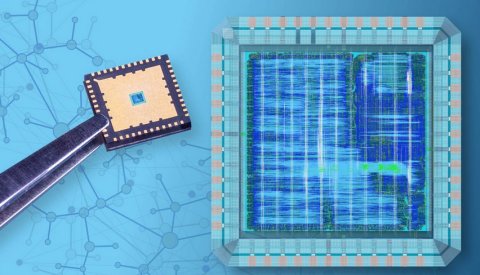Imec Builds World's First Spiking Neural Network-Based Chip for Radar Signal Processing
Flagship use-case includes the creation of a smart, low-power anti-collision radar system for drones that identifies approaching objects in a matter of milliseconds
LEUVEN (Belgium), April 28, 2020 — Imec, a world-leading research and innovation hub in nanoelectronics and digital technologies, today presents the world’s first chip that processes radar signals using a spiking recurrent neural network. Mimicking the way groups of biological neurons operate to recognize temporal patterns, imec’s chip consumes 100 times less power than traditional implementations while featuring a tenfold reduction in latency – enabling almost instantaneous decision-making. For example, micro-Doppler radar signatures can be classified using only 30 mμ of power. While the chip’s architecture and algorithms can easily be tuned to process a variety of sensor data (including electrocardiogram, speech, sonar, radar and lidar streams), its first use-case will encompass the creation of a low-power, highly intelligent anti-collision radar system for drones that can react much more effectively to approaching objects.
Artificial neural networks (ANNs) have already proven their worth in a wide range of application domains. They are a key ingredient, for instance, of the radar-based anti-collision systems commonly used in the automotive industry. But ANNs come with their share of limitations. For one, they consume too much power to be integrated into increasingly constrained (sensor) devices. Additionally, ANNs’ underlying architecture and data formatting requires data to undertake a time-consuming journey from the sensor device to the AI inference algorithm before a decision can be made. Enter spiking neural networks (SNNs).
“Today, we present the world’s first chip that processes radar signals using a recurrent spiking neural network,” says Ilja Ocket, program manager of neuromorphic sensing at imec.
“SNNs operate very similarly to biological neural networks, in which neurons fire electrical pulses sparsely over time, and only when the sensory input changes. As such, energy consumption can significantly be reduced. What’s more, the spiking neurons on our chip can be connected recurrently – turning the SNN into a dynamic system that learns and remembers temporal patterns. The technology we are introducing today is a major leap forward in the development of truly self-learning systems.”
Imec’s novel chip was initially designed to support electrocardiogram (ECG) and speech processing in power-constrained devices. Yet thanks to its generic architecture that features a completely new digital hardware design, it can also easily be reconfigured to process a variety of other sensory inputs like sonar, radar and lidar data. Contrary to analog SNN implementations, imec’s event-driven digital design makes the chip behave exactly and repeatedly as predicted by the neural network simulation tools.
Use-case: a smarter, low-power anti-collision system for drones (and cars)
The drone industry – even more than the automotive sector – works with constrained devices (e.g. limited battery capacity) that need to react quickly to changes in their environment in order to appropriately react to approaching obstacles.
“Hence, a flagship use-case for our new chip includes the creation of a low-latency, low-power anti-collision system for drones. Doing its processing close to the radar sensor, our chip should enable the radar sensing system to distinguish much more quickly – and accurately – between approaching objects. In turn, this will allow drones to nearly instantaneously react to potentially dangerous situations,” says Ilja Ocket. “One scenario we are currently exploring features autonomous drones that depend on their on-board camera and radar sensor systems for in-warehouse navigation, keeping a safe distance from walls and shelves while performing complex tasks. This technology could be used in plenty of other use-cases as well – from robotics scenarios to the deployment of automatic guided vehicles (AGVs) and even health monitoring.”
“This chip meets the industry’s demand for extremely low-power neural networks that truly learn from data and enable personalized AI. For its creation, we rallied experts from various disciplines within imec – from the development of training algorithms and spiking neural network architectures that take neuroscience as a basis, to biomedical and radar signal processing and ultra-low power digital chip design. That is where imec really makes a difference,” Kathleen Philips, program director of IoT cognitive sensing at imec, concludes.

About imec
Imec is a world-leading research and innovation hub in nanoelectronics and digital technologies. The combination of our widely acclaimed leadership in microchip technology and profound software and ICT expertise is what makes us unique. By leveraging our world-class infrastructure and local and global ecosystem of partners across a multitude of industries, we create groundbreaking innovation in application domains such as healthcare, smart cities and mobility, logistics and manufacturing, energy and education.
As a trusted partner for companies, start-ups and universities we bring together more than 4,500 brilliant minds from over 95 nationalities. Imec is headquartered in Leuven, Belgium and has distributed R&D groups at a number of Flemish universities, in the Netherlands, Taiwan, USA, and offices in China, India and Japan. In 2019, imec's revenue (P&L) totaled 640 million euro. Further information on imec can be found at www.imec-int.com.
Related Semiconductor IP
- Ultra-Low-Power LPDDR3/LPDDR2/DDR3L Combo Subsystem
- Parameterizable compact BCH codec
- 1G BASE-T Ethernet Verification IP
- Network-on-Chip (NoC)
- Microsecond Channel (MSC/MSC-Plus) Controller
Related News
- Neurons cast in silicon: AI chip SENNA accelerates spiking neural networks
- BrainChip and Cisco Internet of Everything Innovation Center Sign Agreement to Demonstrate the Capabilities of BrainChip's Spiking Neural Adaptive Processor (SNAP) Technology
- CEVA Introduces WhisPro, Neural Network-Based Speech Recognition Technology For Voice Assistants and IoT devices
- Eta Compute selects IAR Embedded Workbench as the Preferred Toolchain for new neural network-based AI SoCs
Latest News
- ISOLDE Project Demonstrates Advancements in European Open-Source RISC-V for Automotive, Space, and IoT
- ACL Digital and AIM FUTURE Partner to Drive Innovation in Edge AI
- Tenstorrent and PwC Partner to Advance AI Ecosystem Development in Cyprus
- Republic of Cyprus Selects Tenstorrent for AI Innovation
- SiFive and IAR Collaborate to Advance the Automotive Ecosystem and Drive RISC-V Innovation in Automotive Electronics